Deza M.M., Laurent M. Geometry of Cuts and Metrics
Подождите немного. Документ загружается.


344
Chapter
23.
Hypercube Embeddings of
the
Equidistant
Metric
Remark
23.1.6.
The
parameters (k,
A)
with
3
15
for which there ex-
ists a symmetric
(n, k, A)-BIBD (then, n = 1 + by (23.1.1» have been
completely classified (with
the
exception
of
k 13, 1 corresponding
to
the
question of existence of
PG(2,
12»
(see Biggs and
Ito
[1981]). Besides
the
pa-
rameters
corresponding
to
a projective plane, or
to
a
Hadamard
design, or
to
a
dual
of
them,
a symmetric (n,
k,
A)-BIBD exists if
and
only if (n,
k,
A)
is
one of
the
following list: (16,6,2), (37,9,2), '(25,9,3), (16,10,6) (which
is
dual
to
the
case
(16,6,2)),
(56,11,2), (31,10,3), (45,12,3), (79,13,2), (40,13,4), (71,15,3)
and
(36,15,6). I
A useful notion is
that
of extension of a design. Let
13
be
a collection of
subsets
of
Vn
and
let
io
rt.
V
n
. Given
an
integer
.'I,
the .'I-extension
of
13
is
the
collection
13
1
whose blocks are
the
blocks of
13
together with
the
block
{io}
repeated
s times.
23.1.2
Intersecting
Systems
Let A
be
a collection of subsets of a finite set
and
let r, A be positive integers.
Then,
A
is
called a (r,
A)-intersecting
system
if
IAI
r for all A E A
and
IA
n BI = A for all distinct A, B E
A.
The
maximum cardinality
of
a (r,
A)-
intersecting system consisting of subsets of
Vb
is
denoted by
f(r,
A;
b).
A is called a
l::.-,~ystem
with
center
K
and
parameters
(r,
A)
if
IKI
=
A,
IAI
= r for all A E
A,
and
An
B K for all distinct
A,
B E
A.
Clearly,
if
A
consists
of
subsets of
Vb,
then
IAI
::;
Remark
23.1.7.
(r,
A,
n)-designs
and
(r, A)-intersecting systems are basically
the
same
objects. Namely, let M
be
a n x b binary matrix, let
13
denote
the
family
of
subsets of whose incidence vectors are
the
columns
of
lvI,
and
let
A denote
the
family of subsets of
~'b
whose incidence vectors are
the
rows of
M.
Then,
13
is a (r,
A,
n)-design
if
and
only if A is a (r, A)-intersecting system
of
cardinality n. Moreover,
13
is trivial
if
and
only if A is a l::.-system.
As
a
reformulation of Theorem 23.1.3,
f (r,
A;
b)
::;
b holds. These two terminologies
of
(r,
A,
n)-designs
and
intersecting systems are commonly used in the literature;
this is why
we
present
them
both
here. Moreover,
we
will need intersecting
systems
in
Section 24.3.
Note also
that
partial
projective planes of order t (with n lines)
and
(t
+ 1,1)-
intersecting systems (with
n members) are exactly the same notions
and
they
correspond to (t + 1,1, n)-designs (trivial
partial
projective planes or
corresponding
to
l::.-systems). I
By
the
above remark, intersecting systems arise as the h-Iabelings of
the
equidistant metric. Namely,
Proposition
23.1.8.
There is a
one-to-one
correspondence between the
h-
labelings
of
the equidistant
metric
2tlt
n
and
the (2t,
t)-intersecting
systems
of

23.2
Embeddings
of
2tl
n
and
Designs
345
cardinality n
1.
Proof. Indeed,
in
any h-Iabeling
of
2tl
n
,
we
may assume
that
one
of
the
points
is labeled by 0
and
then
the
sets labeling
the
remaining n - 1 points are the
members
of
a (2t, t)-intersecting system. I
Hence,
Theorem
23.1.9 below from Deza [1973b] follows as a reformulation
of
Theorem
22.0.6.
Theorem
23.1.9.
Let t
~
1
be
an integer and let A
be
a
(2t,
t)-intersecting
system.
If
IAI
~
t
2
+ t + 2, then A
is
a tl-system. I
As
an
application
of
Theorem
23.1.9, Deza
[1974]
proved
the
following result, solving
a conjecture
of
Erdos
and
Lovasz.
Theorem
23.1.10.
Let t
~
1
be
an integer and let A
be
a collection
of
subsets
of
a
finite set such that IA
n BI = t for all A I: B E
A.
Set k
max(IAI:
A E
A).
If
IAI
~
k
2
-
k + 2, then A is a t:.-system. I
We conclude
with
an
easy application,
that
will be needed later.
Lemma
23.1.11.
Let k, t
~
1
be
integers such that t < k
2
+ k + 1 and let A
be
a
(k
+ t, t)-intersecting system.
If
IAI
~
k
2
+ k + 3, then A is a
tl-system.
Proof. Let
A1
E A
and
set
A'
:=
{Al'lA1 I A E
A\
{Ad}.
One checks easily
that
AI is a (2k, k)-intersecting system
with
IAII
~
k
2
+ k +
2.
By
Theorem
23.1.9,
AI is a
tl-system.
Let K denote its center,
IKI
= k. Let A E
A,
A
=1=
AI.
Set
alAI
n
KI,
then
IAI
n
((Al'lAt)
\
K)I
= k - a since
Al
n
(Al'lA
1
)
Al
\ A
has
cardinality
k.
If
a::; k 1,
then
implying t
~
(k a)(k2 + k + 1), contradicting the
assumption
on
t.
Hence,
a = k, \
A.
K and, thus,
Al
n
A.
=
Al
\
K.
This
shows
that
A is a
tl-system.
I
23.2
Embeddings
of
2tln
and
Designs
Let t, n
~
1 be integers. Every :l+-realization of 2tJl
n
is
of
the
form
(23.2.1)
2t1
n
=
o(E),
where B is a collection
of
(not necessarily distinct) subsets
of
V
n
.
Let k
~
1 be
an
integer.
The
realization (23.2.1) is said
to
be k-uniform if
lEI
= k, n k for

346
Chapter
23.
Hypercube
Embeddings
of
the
Equidistant
Metric
all E E
B.
It
is very easy
to
construct
IZ+-realizations
of
the
equidistant
metric
from designs.
For
instance,
let
B
be
a
(r,
A,
n)-design.
Then,
L
6(E)
= 2(r -
A)ln.
BEB
Moreover,
if
r
;::::
2A,
then
the
(r - 2A)-extension
of
B yields a IZ+-realization
of
2(r -
A)ln'
namely,
L 6(E) + (r - 2A)6({io}) = 2(r -
A)ln+h
BEB
where
V
n
+
1
\
Vn
= {io}.
In
particular,
each (t +
1,I,n)-design
yields a
IZ+-
realization
of
2t1
n
and
its
(t -
I)-extension
yields a
realization
of
2t1
n
+l.
Also,
the
O-extension
of
a (2t, t, n -
I)-design
gives a IZ+-realization
of
2t1
n
.
If
B is a (n, k, A)-BIBD,
then
(23.2.1) is a IZ+-realization
of
the
equidistant
metric
2A
~=~
In.
In
particular,
if
B is a
Hadamard
design
of
order
4t - 1,
then
(23.2.1) is a IZ+-realization
of
2t14t-l
and
the
O-extension
of
B yields a
IZ+-realization
of
2t14t.
If
B is
PG(2,
t),
then
(23.2.1) is a
IZrrealization
of
2t1
t
2+t+l
and
the
(t -
I)-extension
of
B yields a IZ+-realization
of
2t1
t
2+t+2'
The
next
result
makes precise
the
correspondence
between
IZ+-realizations
of
the
equidistant
metric
and
designs.
The
first
assertion
(i) is
nothing
but
a
reformulation
of
Proposition
23.1.8 (using
the
link
between
intersecting
systems
and
designs,
explained
in
Remark
23.1.7).
Proposition
23.2.2.
(i)
There is a one-to-one correspondence between the IZrrealizations
of
2t1
n
and the (2t, t, n -
1)
-designs.
(ii) For k
i=
~,
there is a one-to-one correspondence between the k-uniform
IZrrealizations
of
2t1
n
and the
(n, k,
t(:-=-~))-BIBD
'so
Proof. (i) follows by
assuming
that
all
blocks E E B
do
not
contain
a given
point
io
of
Vn
(replacing,
if
necessary, E by
Vn
\
E).
(ii)
It
is
immediate
to
check
that
(23.2.1) holds
if
B is a (n, k,
t(:-=-~))_BIBD.
Suppose
now
that
(23.2.1) holds,
with
lEI
= k for all E E B,
and
k
i=
~.
By
taking
the
scalar
product
of
both
sides
of
(23.2.1)
with
the
all-ones vector,
we
obtain
that
the
number
b
of
blocks satisfies
b =
tn(n
-1).
k(n - k)
We show
that
each
point
belongs
to
the
same
number
of
blocks. For
this,
let
r
denote
the
number
of
blocks
that
contain
the
point
1
and
denote
by
ai
the
number
of
blocks
containing
both
points
1
and
i, for i = 2,
...
,n.
Then,
~2<i<n
ai
=
r(k
-1).
Counting
in
two ways
the
total
number
of
units
in
the
incidence-matrix
of
B
(summing
over
the
columns
or
over
the
rows),
we
obtain
bk
= r + L (2t - r + 2ai),
2:'Oi:'On
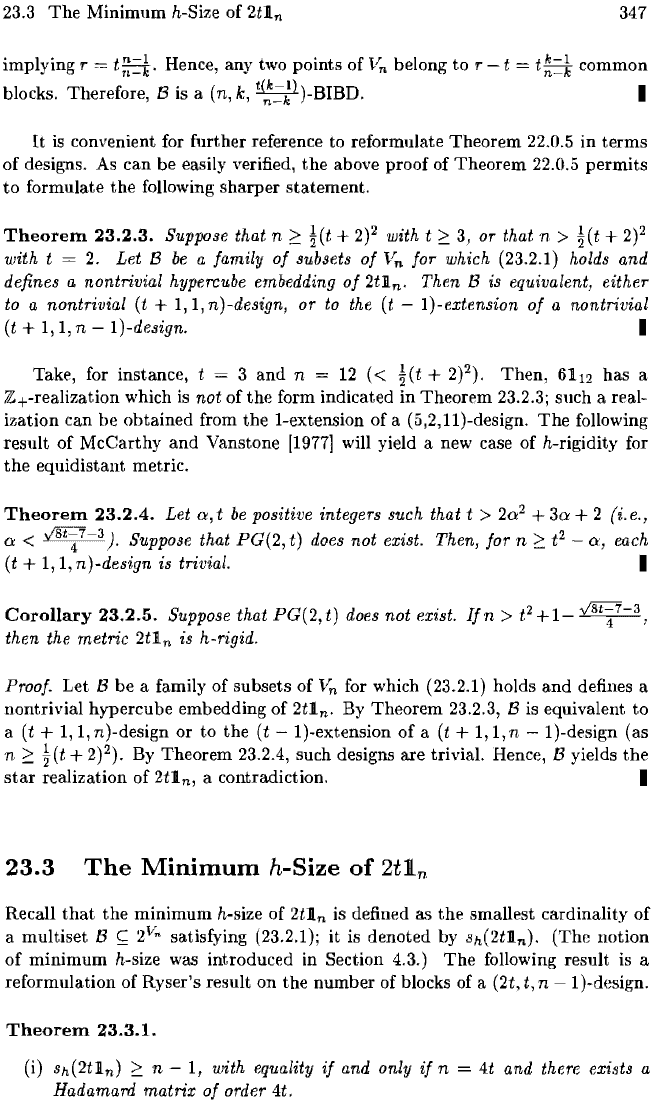
23.3
The
Minimum h-Size of
2tl
n
347
implying
l'
= t
~=~.
Hence, any two points of
Vn
belong to
l'
t = t
!=k
common
blocks. Therefore,
B is a (n, k, I
It
is convenient for further reference to reformulate Theorem 22.0.5
in
terms
of
designs. As
can
be easily verified,
the
above proof
of
Theorem 22.0.5
permits
to
formulate
the
following sharper statement.
Theorem
23.2.3.
Suppose that n
;:::
~(t
+
2)2
with t
;:::
3, or that n >
!(t
+
2?
with t
2.
Let B
be
a family
of
subsets
of
Vn
for which (23.2.1) holds and
defines a nontrivial hypercube embedding
of
2tl
n
•
Then B is equivalent, either
to
a nontrivial
(t
+ 1,1, n)-design, or
to
the (t - I)-extension
of
a nontrivial
(t + 1,1, n I)-design. I
Take, for instance, 3 and n =
12
«
!(t
+ 2)2). Then,
61
12
has a
Z+-realization which is
not of the form indicated
in
Theorem 23.2.3; such a real-
ization can be obtained from the I-extension
of
a (5,2,1l)-design.
The
following
result of McCarthy
and
Vanstone
[1977]
will yield a new case
of
h-rigidity for
the
equidistant metric.
Theorem
23.2.4.
Let
0:,
t
be
positive integers such that t >
20:
2
+
30:
+ 2 (i.e.,
0:
< Suppose that PG(2, t)
does
not exist. Then, for n
;:::
t
2
-
0:,
each
(t + 1,1, n )-design is trivial. I
Corollary
23.2.5.
Suppose that PG(2, t)
does
not exist.
lfn>
t
2
+1-
~-3,
then the metric
2tl
n
is h-rigid.
Proof. Let B
be
a family
of
subsets of
Vn
for which (23.2.1) holds
and
defines a
nontrivial hypercube embedding
of
2tl
n
.
By Theorem 23.2.3, B is equivalent to
a
(t + 1,1, n)-design or
to
the
(t - I)-extension
of
a (t +
1,1,
n - I)-design (as
n;:::
!(t
+ 2)2). By Theorem 23.2.4, such designs are trivial. Hence, B yields
the
star
realization
of
2tl
n
,
a contradiction. I
23.3
The
Minimum
h-Size
of
2tln
Recall
that
the
minimum h-size
of
2tl
n
is defined as the smallest cardinality
of
a multiset B
~
2
v
"
satisfying (23.2.1);
it
is denoted by
sh(2tl
n
).
(The notion
of
minimum
h-size was introduced in Section 4.3.)
The
following result is a
reformulation of Ryser's result on
the
number
of
blocks of a (2t, t, n I)-design.
Theorem
23.3.1.
(i)
sh(2tl
n
)
;:::
n 1, with equality
if
and only
if
n = 4t and there exists a
Hadamard matrix
of
order 4t.
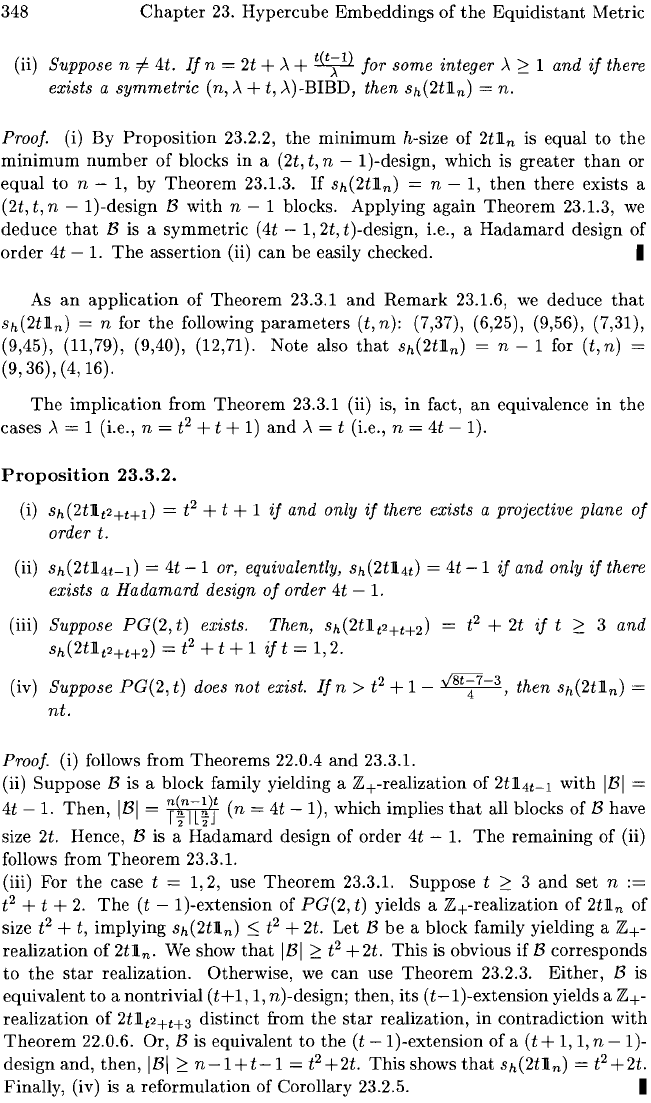
348
Chapter
23. Hypercube
Embeddings
of
the
Equidistant
Metric
(ii)
Suppose n
=I-
4t.
If
n = 2t + A +
t(t~l)
for some integer A
:::::
1 and
if
there
exists a symmetric
(n, A + t, A)-BIBD, then
sh(2t.D.
n
)
= n.
Proof. (i) By
Proposition
23.2.2,
the
minimum
h-size of
2t.D.
n
is equal
to
the
minimum
number
of
blocks
in
a (2t, t, n - I)-design, which is greater
than
or
equal
to
n -
1,
by
Theorem
23.1.3.
If
sh(2t.D.
n
)
= n - 1,
then
there
exists a
(2t, t, n - I)-design B
with
n - 1 blocks. Applying again
Theorem
23.1.3,
we
deduce
that
B
is
a
symmetric
(4t -
1,
2t, t)-design, Le., a
Hadamard
design of
order
4t
-
1.
The
assertion (ii)
can
be easily checked. I
As
an
application
of
Theorem
23.3.1
and
Remark
23.1.6,
we
deduce
that
sh(2t.D.
n
)
= n for
the
following
parameters
(t,n): (7,37), (6,25), (9,56), (7,31),
(9,45), (11,79), (9,40), (12,71). Note also
that
sh(2t.D.
n
)
= n - 1 for
(t,n)
=
(9,36), (4, 16).
The
implication
from
Theorem
23.3.1 (ii) is,
in
fact,
an
equivalence
in
the
cases A = 1 (i.e., n = t
2
+ t + 1)
and
A = t (Le., n =
4t
- 1).
Proposition
23.3.2.
(i)
Sh(2t.D.
t
2+t+l)
= t
2
+ t + 1
if
and only
if
there exists a projective plane
of
order
t.
(ii) sh(2t.D.4t-l) = 4t
-1
or,
equivalently,
sh(2t.D.4t)
=
4t
-1
if
and only
if
there
exists a Hadamard design
of
order 4t -
1.
(iii) Suppose
PG(2,
t)
exists. Then,
sh(2t.D.
t
2+t+2)
= t
2
+ 2t
if
t
:::::
3 and
sh(2t.D.t2+t+2)
= t
2
+ t + 1
if
t =
1,2.
(iv) Suppose
PG(2,
t) does not exist.
If
n > t
2
+ 1 -
y'8t:;-7-3,
then
sh(2t.D.
n
)
=
nt.
Proof. (i) follows from
Theorems
22.0.4
and
23.3.1.
(ii) Suppose
B is a block family yielding a Z+-realization of 2t.D.4t-l
with
IBI
=
4t -
1.
Then,
IBI
=
r~L~)Jt
(n
= 4t - 1), which implies
that
all blocks of B have
size
2t. Hence, B is a
Hadamard
design of order
4t
-
1.
The
remaining of (ii)
follows from
Theorem
23.3.1.
(iii) For
the
case t =
1,2,
use
Theorem
23.3.1. Suppose t
:::::
3
and
set n
:=
t
2
+ t +
2.
The
(t -
I)-extension
of
PG(2,
t) yields a Z+-realization
of
2t.D.
n
of
size t
2
+ t, implying
sh(2t.D.
n
)
:S
t
2
+ 2t. Let B
be
a block family yielding a Z+-
realization
of
2t.D.
n
.
We show
that
IBI
:::::
t
2
+ 2t.
This
is
obvious if B corresponds
to
the
star
realization. Otherwise,
we
can
use
Theorem
23.2.3.
Either,
B is
equivalent
to
a nontrivial
(t+
1,1,
n)-design;
then,
its
(t-I)-extension
yields a Z+-
realization
of
2t.D.t2+t+3
distinct
from
the
star
realization,
in
contradiction
with
Theorem
22.0.6. Or, B is equivalent
to
the
(t - I)-extension of a
(t
+
1, 1,
n - 1)-
design
and,
then,
IBI
:::::
n-I
+t-I
= t
2
+2t.
This
shows
that
sh(2t.D.
n
)
= t
2
+2t.
Finally, (iv)
is
a reformulation of Corollary 23.2.5. I

23.3
The
Minimum
h-Size of
2t:D.
n
349
Set
t f
n
(n-1)t1
f
2t1
an
:=
lIJ
III
=
4t
-
III
.
By
taking
the
scalar
product
of
both
sides of (23.2.1)
with
the
all-ones vector,
we
obtain
the
following bounds:
The
equality
sh(2t:D.
n
)
=
nt
holds if
and
only if
the
star
realization (22.0.1)
is
the
only Z+-realization
of
2t1
n
,
i.e., if
2t:D.
n
is h-rigid.
This
is
the
case, for instance, if n
2:
t
2
+ t + 3 (by
Theorem
22.0.6). Several
other
results
about
classes of
parameters
n, t for which
2t:D.
n
is h-rigid have
been
given in
Chapter
22.
A
natural
question is
what
are
the
parameters
n,
t for which
the
equality
holds.
If
2t:D.
n
admits
a Z+-realization
L:s
>'s8(S) where
>'5
> 0 only if
8(S)
is
an
equicut (i.e., satisfies
lSI
= liJ, lil),
then
the
equality
Sh(2tl
n
)
=
a~
holds.
For instance,
Sh(417) =
a¥
= 7
and
Sh(418) =
a§
= 7, as each of 417
and
418
has a
Z+-realization
using only equicuts (see
Proposition
23.4.4).
Clearly (from
Theorem
23.3.1),
the
equality
sh(2t:D.
n
)
=
a~
can occur only if
n
:::;
4t.
The
case n =
4t
is
well understood: equality holds if
and
only if
there
exists a
Hadamard
matrix
of order 4t.
The
following conjectures are
posed
by
Deza
and
Laurent
[1993c].
Conjecture
23.3.3.
Suppose
that
n
:::;
4t
and that there exists a Hadamard
matrix
of
order
4t.
Then,
sh(2t:D.
n
)
=
a~.
Conjecture
23.3.4.
Suppose
that
n
:::;
4t
and
that there exist Hadamard
matri-
ces
of
suitable orders. Then,
sh(2t:D.
n
)
=
a~.
Conjecture
23.3.4 is obviously weaker
than
Conjecture 23.3.3
(the
word "suit-
able"
remains
to
be
defined
in
an
appropriate
way). We refer
to
Deza
and
Laurent
[1993c] for
partial
results
related
to these conjectures.
In
particular,
the
following results are proved there.
Proposition
23.3.5.
(i) Conjecture 23.3.3 holds
for
all
n,
t such
that
n
:::;
4t,
and
¥-
<
II
l
or
min(
n,
t)
:::;
20.
(ii) Conjecture 23.3.4 holds for all
n,
t
such
that
n is even
and
satisfies
2V2t
:::;
n
:::;
4t.
(It
suffices to
assume
the existence
of
Hadamard
matrices
of
orders
2n,
4n,
and
n
(if
i is
even)
and n + 2
(if
i is odd).) I
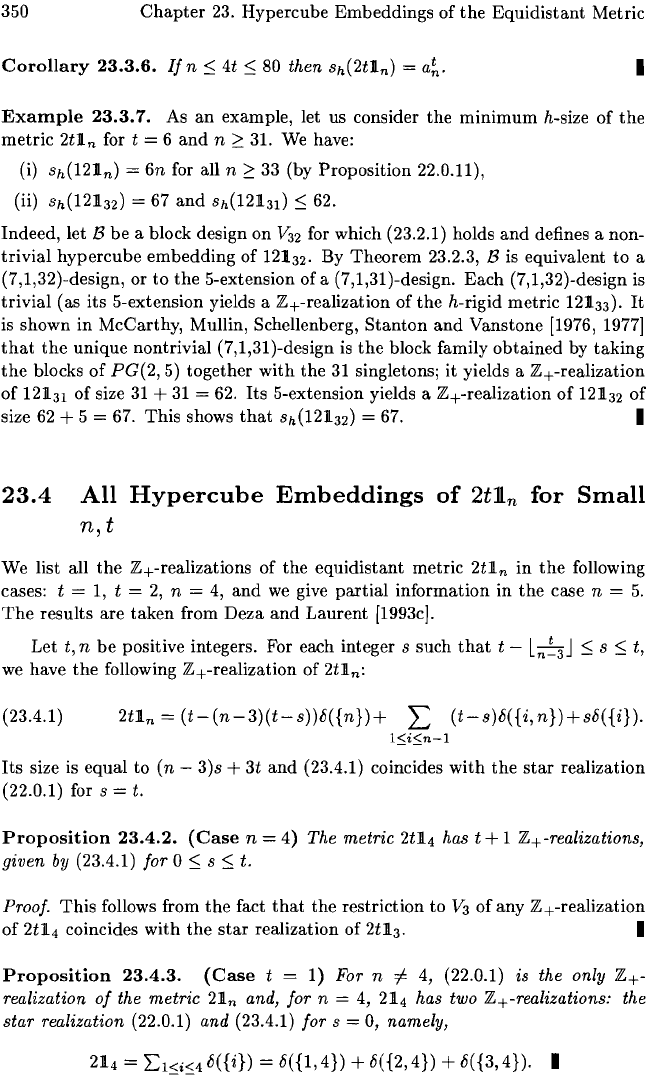
350
Chapter
23.
Hypercube Embeddings of
the
Equidistant
Metric
Corollary
23.3.6.
If
n
:S
4t
:S
80
then
sh(2t:D.
n
)
=
a~.
I
Example
23.3.7.
As
an
example, let us consider the
minimum
h-size
of
the
metric
2t:D.
n
for t = 6
and
n
2:
31.
We
have:
(i)
sh(l211
n
)
=
6n
for all n
2:
33
(by Proposition 22.0.11),
(ii)
sh(12132)
= 67
and
sh(121131)
:S
62.
Indeed, let
B
be
a block design on V
32
for which (23.2.1) holds
and
defines a non-
trivial
hypercube
embedding of 12132. By Theorem 23.2.3, B is equivalent
to
a
(7,1,32)-design, or
to
the
5-extension of a (7,1,31)-design. Each (7,1,32)-design is
trivial
(as its 5-extension yields a Z+-realization of
the
h-rigid metric
121133).
It
is shown
in
McCarthy, Mullin, Schellenberg,
Stanton
and
Vanstone [1976, 1977]
that
the
unique nontrivial (7,1,31)-design
is
the
block family obtained by taking
the
blocks
of
PG(2,
5)
together
with
the
31
singletons; it yields a Z+-realization
of
121131
of
size
31
+
31
= 62. Its 5-extension yields a Z+-realization
of
121132
of
size
62
+ 5 = 67.
This
shows
that
sh(121132)
= 67. I
23.4
All
Hypercube
Embeddings
of
2tlln for
Small
n,
t
We list all
the
Z+-realizations of the equidistant metric
2t:D.
n
in
the
following
cases: t =
1,
t =
2,
n =
4,
and
we
give
partial
information in
the
case n =
5.
The
results are
taken
from Deza
and
Laurent [1993c].
Let t,
n
be
positive integers. For each integer s such
that
t -
ln~3J
:S
s
:S
t,
we
have
the
following Z+-realization of
2t:D.
n
:
(23.4.1)
2t:D.
n
=
(t-(n-3)(t-s))8({n})+
L
(t-s)8({i,n})+s8({i}).
l:<;i:<;n-l
Its
size is equal to
(n
-
3)s
+
3t
and
(23.4.1) coincides with
the
star
realization
(22.0.1) for s = t.
Proposition
23.4.2.
(Case
n = 4)
The
metric
2t:D.4
has
t + 1
Z+-realizations,
given
by (23.4.1)
for
0
:S
s
:S
t.
Proof.
This
follows from
the
fact
that
the restriction to
V3
of
any Z+-realization
of
2t:D.4
coincides with
the
star
realization of
2t:D.3.
I
Proposition
23.4.3.
(Case
t = 1) For n I- 4, (22.0.1) is
the
only
Z+-
realization
of
the
metric
21n
and,
for
n = 4, 214
has
two
Z+-realizations:
the
star
realization
(22.0.1)
and
(23.4.1)
for
s = 0,
namely,
2114=2:1:<;i:<;48({i})
=8({1,4})
+8({2,4})
+8({3,4}).
I
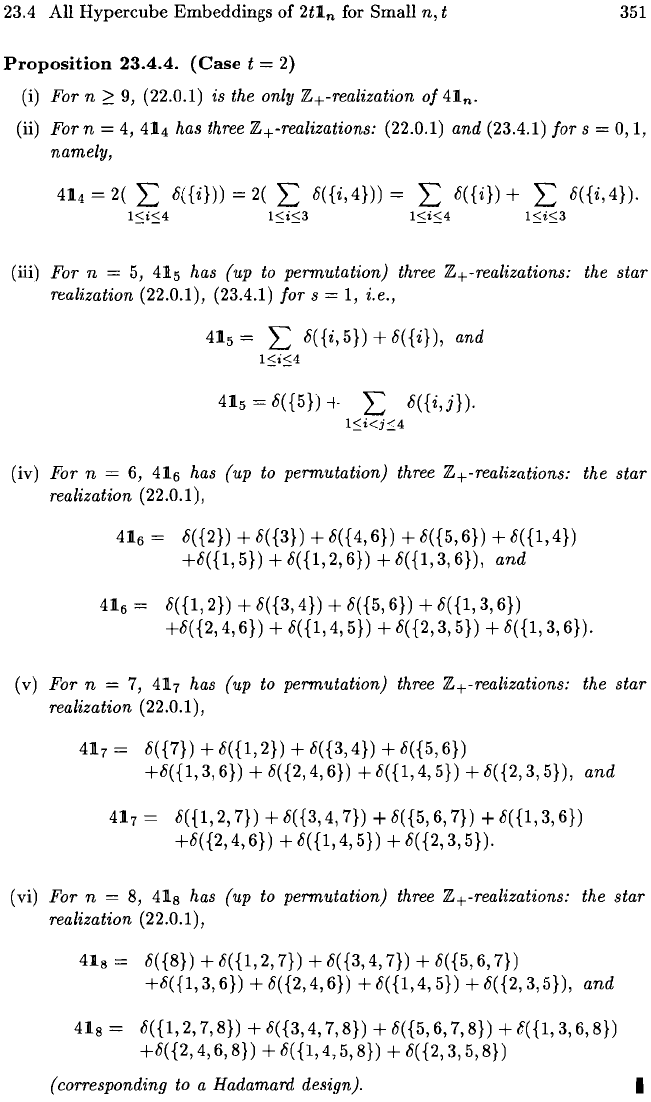
23.4 All Hypercube Embeddings of
2tln
for
Small
n,
t
351
Proposition
23.4.4.
(Case
t = 2)
(i)
For n
2:
9,
(22.0.1) is the only Z+-realization
of
4lL
n
.
(ii) For n =
4,
4lL4
has three Z+-realizations: (22.0.1) and (23.4.1) for s = 0,1,
namely,
4lL4
=
2(
:E
8({i}))
=
2(
:E
8({i,4}))
=
:E
8({i})
+
:E
8({i,4}).
(iii) For n = 5, 415 has (up
to
permutation) three Z+-realizations: the
star
realization (22.0.1), (23.4.1)
for
s =
1,
i.e.,
4lL5
=
:E
8({i,5})
+8({i}),
and
1$i$4
4lL5=8({5})+
:E
8({i,j}).
1$i<j$4
(iv) For n =
6,
4lL6
has (up to permutation) three Z+-realizations: the
star
realization (22.0.1),
4lL6
= 8({2}) +8({3})
+8({4,6}) +8({5,6}) +8({1,4})
+8({1,5})
+8({1,2,6})
+8({1,3,6}),
and
4lL6
= 8({1,2})
+8({3,4}) +8({5,6})
+8({1,3,6})
+8({2,4,6})
+8({1,4,5}) +8({2,3,5})
+8({1,3,6}).
(v) For n =
7,
4lL7
has (up to permutation) three Z+-realizations: the
star
realization (22.0.1),
4lL7
= 8({7})
+8({1,2}) +8({3,4}) +8({5,6})
+8({1,3,6})
+8({2,4,6})
+8({1,4,5})
+8({2,3,5}),
and
4lL7
=
8(
{I,
2,
7})
+
8(
{3,
4,
7})
+
8(
{5,
6,
7})
+
8(
{I,
3,
6})
+8(
{2,
4,
6})
+
8(
{I,
4,
5}) +
8(
{2,
3,
5}).
(vi) For n =
8,
4lL8
has (up to permutation) three Z+-realizations: the
star
realization (22.0.1),
418 = 8({8})
+8({1,2,7})
+8({3,4,7})
+8({5,6,7})
+8({1,3,6})
+8({2,4,6}) +8({1,4,5})
+8({2,3,5}),
and
4lL8
= 8({1,2,7,8})
+8({3,4,7,8}) +8({5,6,7,8})
+8({1,3,6,8})
+8({2,4,6,8})
+8({1,4,5,8})
+8({2,3,5,8})
(corresponding to a Hadamard design).
I
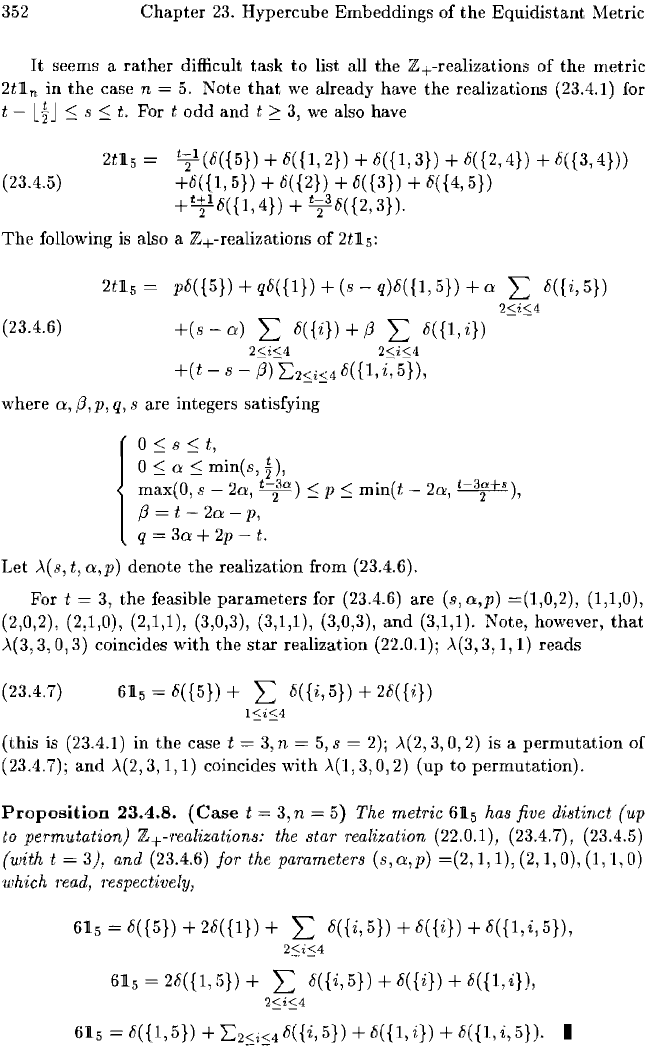
352
Chapter
23.
Hypercube Embeddings
of
the Equidistant Metric
It
seems a
rather
difficult task
to
list all the Z+-realizations
of
the metric
2t1
n
in
the case n
5.
Note
that
we
already have the realizations (23.4.1) for
t -
L~J
S;
li
S;
t. For t
odd
and t
2:
3,
we
also have
2t15
(23.4.5)
t21 (6( {5}) +
6(
{I,
2})
+
6(
{I,
3}) +
6(
{2,
4})
+
6(
{3,
4}»
H{{1,5})
+6({2})
+6({3})
+6({4,5})
+t¥6({1,4})
+ t236({2,3}).
The
following is also a Z+-realizations
of
2t15:
2t15
p6({5})+q6({1})+(8-q)6({1,5})+a
L 6({i,5})
2SiS4
(23.4.6)
+(8-a)
L
6({i})+/3
L 8({1,i})
2<i<4
+(t
8
6(
{I,
i~
5}),
where
a,
,a,p,
q,,5
are integers satisfying
{
OS;
8
S;
t,
OS;
0:
S;
mines, !),
max{O,
s -
20',
t-;"')
S;
p
/3
= t -
20'
p,
q =
30'
+
2p
-
t.
min(t -
20',
t-
3
f+
S
),
Let )..(s,t,a,p) denote the realization from (23.4.6).
For t = 3, the feasible parameters for (23.4.6) are
a,p)
=(1,0,2), (1,1,0),
(2,0,2), (2,1,0), (2,1,1), (3,0,3), (3,1,1), (3,0,3),
and
(3,1,1). Note, however,
that
),,(3,3,0,3) coincides
with
the
star
realization (22.0.1); ),,(3,3,1,1) reads
(23.4.7)
615
= 6({5}) + L 8({i,5}) + 26({i})
ISiS4
(tbis is (23.4.1)
in
the
case t =
3,
n = 5,8 =
2);
),,(2,3,0,2) is a
permutation
of
(23.4.7);
and
,\,(2,3,1,1) coincides with ,\,(1,3,0,2) (up
to
permutation).
Proposition
23.4.8.
(Case
t = 3, n = 5) The metric
615
has five dist'inct (up
to permutation) Z+-realizations: the star realization
(22.0.1), (23.4.7), (23.4.5)
(with t 3), and (23.4.6) for the parameters (8,a,p) 1,1),
(2,
1,0),
(1,1,0)
'Which
read, respectively,
615
6({5}) +26({1}) + L 6({i,5})
+8({i})
+6({1,i,S}),
615
26({1,5})+
L
6({i,5})+6({i})+6({1,i}),
2SiS4
615 8({1,S}) +
6({i,S})
+6({1,i})
+6({1,i,5}).
I
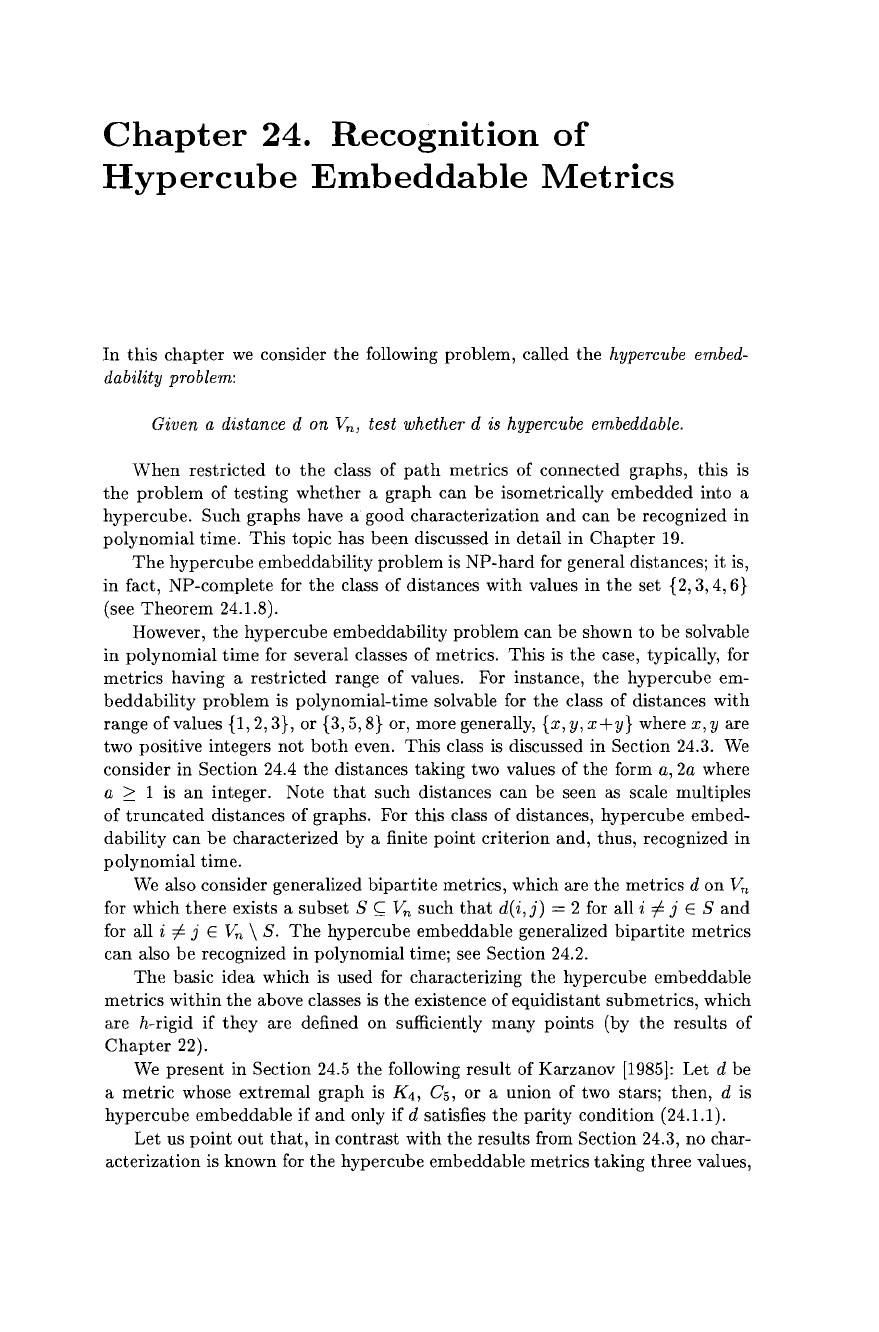
M.M. Deza, M. Laurent, Geometry of Cuts and Metrics, Algorithms and Combinatorics 15,
DOI 10.1007/978-3-642-04295-9_24, © Springer-Verlag Berlin Heidelberg 2010
Chapter
24.
Recognition
of
Hypercube
Embeddable
Metrics
In
this
chapter
we
consider
the
following problem, called
the
hypercube embed-
dability problem:
Given a distance d on V
n
,
test whether d is hypercube embeddable.
When
restricted
to
the
class of
path
metrics of connected graphs,
this
is
the
problem
of
testing
whether
a
graph
can
be
isometrically
embedded
into a
hypercube.
Such
graphs
have a good characterization
and
can
be
recognized
in
polynomial
time.
This
topic has
been
discussed
in
detail
in
Chapter
19.
The
hypercube
embeddability
problem is
NP-hard
for general distances;
it
is,
in
fact,
NP-complete
for
the
class of distances
with
values
in
the
set {2, 3, 4,
6}
(see
Theorem
24.1.8).
However,
the
hypercube
embeddability problem
can
be
shown
to
be
solvable
in
polynomial
time
for several classes of metrics.
This
is
the
case, typically, for
metrics
having a
restricted
range of values. For instance,
the
hypercube
em-
beddability
problem
is
polynomial-time solvable for
the
class of distances
with
range
of
values
{1,2,3},
or
{3,5,8}
or, more generally,
{x,y,x+y}
where
x,y
are
two positive integers
not
both
even.
This
class is discussed
in
Section 24.3.
We
consider in Section 24.4
the
distances
taking
two values of
the
form a, 2a where
a
2:
1 is
an
integer. Note
that
such distances
can
be
seen as scale multiples
of
truncated
distances
of
graphs. For
this
class
of
distances,
hypercube
embed-
dability
can
be
characterized by a finite
point
criterion
and,
thus,
recognized
in
polynomial
time.
We
also consider generalized
bipartite
metrics, which are
the
metrics d
on
Vn
for which
there
exists a
subset
S
<:;:
Vn
such
that
d(
i,
j)
= 2 for all i
=f.
j E
Sand
for all i
#-
j E
Vn
\
S.
The
hypercube
embeddable
generalized
bipartite
metrics
can
also
be
recognized
in
polynomial time; see Section 24.2.
The
basic idea which is used for characterizing
the
hypercube
embeddable
metrics
within
the
above classes
is
the
existence
of
equidistant
submetrics,
which
are h-rigid if
they
are defined
on
sufficiently
many
points
(by
the
results of
Chapter
22).
We present in Section 24.5
the
following result of Karzanov [1985]: Let d
be
a
metric
whose
extremal
graph
is K
4
,
C
5
,
or a union of two stars;
then,
d is
hypercube
embeddable
if
and
only if d satisfies
the
parity
condition (24.1.1).
Let us
point
out
that,
in
contrast
with
the
results from Section 24.3, no char-
acterization
is known for
the
hypercube
embeddable
metrics
taking
three
values,
